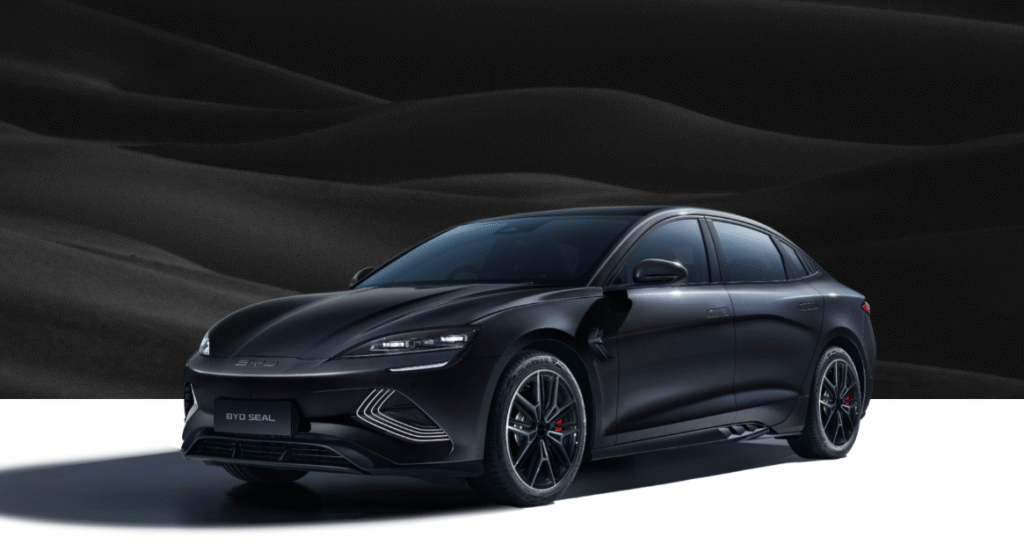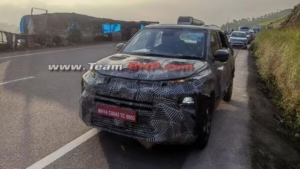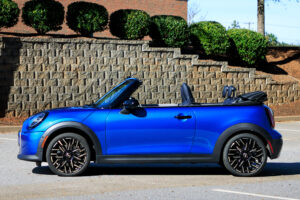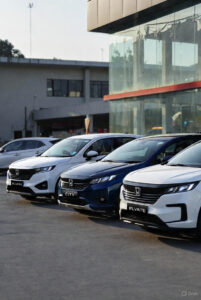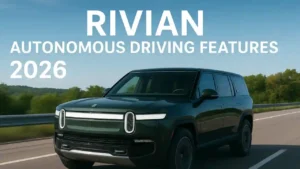The BYD Seal is a premium electric sedan from China’s BYD (Build Your Dreams), positioned to compete with other EV sedans globally. It strikes a balance of performance, range, tech, and style. It has multiple variants, battery options, and is available in different markets (including India). This review captures the full detail as of the latest model years (2024-2025) — what you get in each trim, what performance & features are like, what the pricing is, and what you should know if you’re considering one.
Variants / Trims
BYD Seal is offered in three primary variants in many markets (like India), each differing by battery size, motor layout (RWD vs AWD), performance, and range. Those trims are:
| Trim / Variant | Drivetrain / Motor Layout | Battery Size | Key Differentiators |
|---|---|---|---|
| Dynamic | Rear-Wheel Drive (RWD), single motor | ~61.44 kWh (Blade / LFP battery) | Entry variant: lower power, lower price, decent range; fewer premium features compared to higher trims. |
| Premium | RWD, single motor | ~82.56 kWh | Larger battery, higher power, more range, better equipment and features. |
| Performance | All-Wheel Drive (AWD), dual motors | ~82.56 kWh | Highest performance: fastest acceleration, biggest torque, additional features/hardware for handling and comfort. |
Top Model
The top trim is the Performance variant. What it brings on board:
- Dual motor setup (AWD) giving high output (power and torque).
- Faster acceleration (0-100 km/h in ~3.8 seconds in some markets).
- Premium hardware for ride & handling: upgraded suspension or adaptive damping, better charging capability, more features in safety / driver assistance.
- All the luxury / tech options that BYD offers in this sedan line.
Price (USD & Local)
Here are representative pricing numbers, particularly focusing on India and also converted or compared to other markets:
| Variant | Ex-Showroom Price (India) | Approx USD Equivalent* |
|---|---|---|
| Dynamic (61.44 kWh, RWD) | ₹41,00,000 | ≈ $49,000-$52,000 depending on taxes/exchange rates |
| Premium (82.56 kWh, RWD) | ₹45,70,000 | ≈ $55,000-$60,000 |
| Performance (82.56 kWh, AWD) | ₹53,15,000 | ≈ $67,000-$70,000 |
*USD equivalents are rough, based on typical exchange rates; actual landed price (taxes, import duties) may differ significantly in your country.
In other markets (Australia, China, Southeast Asia etc.), pricing differs, usually with similar trim structures but local adjustments. For example, in some markets the base Dynamic is priced lower when subsidies / incentives are applied.
Full Specifications (Representative)
Here is a tabular overview of what the Seal offers in its variants, focusing on key spec areas: performance, range, dimensions, features.
| Spec | Dynamic (RWD) | Premium (RWD) | Performance (AWD) |
|---|---|---|---|
| Battery Capacity | ~61.44 kWh | ~82.56 kWh | ~82.56 kWh |
| Peak Power (Motor) | ~150 kW (~201-204 hp) | ~230-312 hp depending on region | ~390 kW (~523 bhp) |
| Peak Torque | ~310 Nm | ~360 Nm | ~670 Nm |
| Range (claimed) | ~510 km | ~650 km | ~580 km |
| Acceleration (0-100 km/h) | ~7.5 seconds | ~5.9 seconds | ~3.8 seconds |
| Top Speed | ~180 km/h (all variants) | ||
| Dimensions (L×W×H) | ~4,800 mm × 1,875 mm × 1,460 mm; wheelbase ~2,920 mm | ||
| Kerb Weight | ~1,920-2,000 kg (varies by variant) | ||
| Boot Space | ~400 litres | ||
| Ground Clearance | ~145 mm | ||
| Charging (AC) | 7-kW AC charging (0-100%) in ~12-16 hours depending on capacity | ||
| Charging (DC Fast) | ~110 kW for base, ~150 kW for Premium & Performance (10-80% times vary) |
Features & Equipment
Here are notable features which are common or available (especially on higher trims) in the BYD Seal:
- Large infotainment / touchscreen (15.6-inch in many markets)
- Digital instrument cluster
- Panoramic glass roof / sunroof in some markets
- Advanced driver assistance systems (ADAS): adaptive cruise control, lane keep, etc.
- 360-degree surround camera / parking sensors
- Multiple airbags (eight or more depending on variant)
- Wireless Apple CarPlay / Android Auto
- Wireless charging for devices
- Premium interior touches in higher trims: ventilated / heated seats, better upholstery
- Vehicle-to-Load (V2L) functionality in some trims.
Pros & Cons
Pros
- Impressive range for its battery size, especially in RWD Premium trim.
- Very strong performance in the AWD “Performance” model, with excellent acceleration.
- Good combination of tech and luxury features for its price.
- BYD’s “Blade Battery” (LFP) is considered safer / more durable by many.
- Competitive price in many markets, especially with government incentives.
Cons
- Moderate ground clearance makes it less ideal for rough roads or underbody obstacles.
- Actual real-world range lower than claimed in many climates or with heavy use / high speed.
- Charging infrastructure support depends heavily on region; fast charging stations may not be universally available.
- Price for top trims gets quite high; operating cost of performance model will be steeper (tires, service, insurance).
- Some features (e.g. adaptive suspension, premium interior materials) are only in top trims, so buyers need to spend more to get full package.
Price & Market Positioning
- In markets like India, it sits in the ₹41-53 Lakh ex-showroom price band (for variants from base Dynamic to Performance AWD).
- In other countries, base models tend to start below or around US$50,000, while Performance AWD trims go higher, possibly US$65,000-70,000+ depending on import/taxes.
- Positioned against rivals like Tesla Model 3, Hyundai Ioniq 5 / EV6, and other premium electric sedans — it competes well on features, tech and price under many incentives.
Real-world & Reviewer Notes
- Reviewers note that the AWD performance model is seriously quick, especially for its class, with near supercar-like 0-100 km/h numbers.
- Ride comfort in higher trims is good. The suspension becomes more capable with upgraded damping / handling hardware. Base trims may feel stiffer or less refined on rough surfaces.
- Interior space is good for a sedan; boot is decent (~400 L), and build quality is considered above average.
- Charging times and real range depend heavily on conditions (weather, driving style, speed). People testing long drives note that fast charging (DC) is essential for convenience.
- After-sales, service network, warranty, and software updates (firmware / ADAS calibration) are key differentiators per region.
Frequently Asked Questions (FAQ)
Q: What battery sizes does the Seal offer?
A: Two main battery capacities — ~61.44 kWh for base Dynamic, and ~82.56 kWh for Premium & Performance trims.
Q: What is the difference between RWD and AWD versions?
A: RWD (single motor) versions are simpler, more efficient, lower price; AWD (dual motor) adds performance, torque, handling, but trades off some range and cost.
Q: How much range does each variant have?
A: Base Dynamic ≈ 510 km claimed (on local range cycles); Premium (RWD) ≈ 650 km; Performance (AWD) ≈ 580 km
Q: What is the acceleration for Performance model?
A: About 3.8 seconds for 0-100 km/h in the top Performance AWD trim.
Q: What are the dimensions and boot space?
A: Length ~4,800 mm, width ~1,875 mm, height ~1,460 mm; boot ~400 litres.
Q: What kind of charging support does it have?
A: AC Charging 7 kW for full charge (0-100%) in ~12−16 hours depending on variant; DC Fast charging up to ~110 kW on base, ~150 kW in Premium/Performance variants for faster charge (10-80%)
Q: What safety and driver assist features?
A: Multiple airbags (8 or more depending on trim), ADAS features, rear parking sensors / 360-degree cameras, lane-keep / adaptive cruise in many markets.
Q: How does the BYD Seal compare to rivals?
A: It offers strong value in performance + range vs many rivals, often undercuts premium brands on price. But some rivals may offer slightly better charging infrastructure, service support, brand cachet.
Conclusion
The BYD Seal is a very compelling electric sedan: strong range (especially in Premium RWD), high performance in the AWD version, lots of features, solid build. If your priority is a sedan that gives you both luxury + performance + modern tech, it’s a very good choice.
If instead your priorities are maximum rugged usage, off-road, or lowest operating cost (especially for charging / maintenance), then you might find trade-offs – ground clearance is modest, top trims cost more, fast charging availability may vary.

